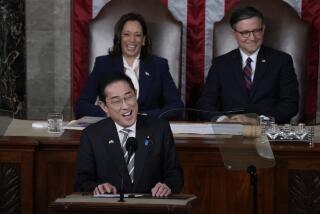Will Japan’s Catch-22 Push the World Into Recession?
- Share via
WASHINGTON — Remember Japan, Inc.? Not that long ago, the specter of an unstoppable Japanese economic juggernaut about to run over the United States was the great fear. Today’s fear, as the head of Sony Corp. warned, is that Japan’s economy may be on the “verge of collapse.” Even in an Asia that suddenly has gone from miracle to widespread malaise, Japan stands out for the size and persistence of its stagnation.
Last week, the Japanese government, saddled with more than $600 billion in bad bank loans, set off a “big bang” to deal with the stagnation. In reality, big bang is a calibrated, phased opening of Japan’s insular financial system, while its 19 largest banks write off $77 billion of some $600 billion in bad debt and the government works out the details of a $124-billion stimulus package. These moves, it is hoped, will pull Japan out of seven years of near-zero economic growth. But a huge budget deficit, the fallout from a record 71,000 bankruptcies last year, a steadily declining yen and stock market, and a still wobbly financial system threaten to overshadow any gains from big bang and plunge the world into recession. Amazingly, this has, so far, produced no sense of crisis in Japan.
The political inertia and inability of the world’s second-largest economy to restore growth looms as the major obstacle to economic recovery in Asia. Japan accounts for about two-thirds of East Asia’s economy. A stagnant Japan cannot absorb exports from recovering economies in Korea and Thailand. Since Japanese banks accounted for about 40% of the capital flows to the region, new investment isn’t likely soon, either. Compared with China, which has pledged not to devalue its currency, accelerate economic reform and take steps to boost flagging economic growth, Japan appears more the laggard than the regional leader and active U.S. partner it professes to be.
Why? Japan’s speculative bubble economy burst in the late 1980s, exposing the flaws of a cozy, economically incestuous system based on personal and mutual back-scratching. But instead of reforming the system, Japan’s Finance Ministry used its mammoth reserves and public savings to keep it on artificial supports. The irony of the latest rescue operation, lost on Japan’s politicians and bureaucrats, is that the government is getting deeper into the banking business even as its reforms purportedly remove it from the market.
In short, Japan is in a state of denial. Rather than deregulate its economy and allow “creative destruction” to occur, Japan relies on the old nostrum of export-led growth. How else can one explain a $124-billion stimulus package that produces only a big yawn? Indeed, since 1992, Tokyo has unveiled some $700-billion worth of stimulus packages, much of it pork funneled into the political system. With Upper House elections in July, its construction industry in trouble and the ruling Liberal Democratic Party seeking to consolidate its position, few expect the latest package to differ much from its predecessors.
What is more puzzling and frustrating to the outside observer than the glacial pace of change in Japan is the sense that the problem is not widely perceived as a problem. In one sense, this is to be expected: Japan is an extraordinarily conservative and risk-averse society. For the average Japanese, prices have been stable for decades. Unemployment has been relatively tame, though of late it has jumped to a postwar record of 3.6%. The Japanese have parked some $9 trillion in government savings institutions and seem content to earn less than 1% in interest for having done so.
Those who benefit most from the status quo--the bureaucrats, the financiers, the exporters--are the most complacent. Japan’s economic Mandarins still extol the virtues of Japan’s collective capitalism despite seven years of virtually no growth. They appear unable to admit that state-directed capitalism, which served the country so well during the Cold War, no longer works.
Yet, over the past decade, incremental change has occurred in Japan. The pressures of globalization and the new information economy gradually have eroded the Japanese model. The Keiretsu system--interrelated families of firms doing business together--is no longer all-pervasive: Japanese multinationals now go outside traditional financing and supply relationships. Japan’s subsidized “mom and pop” distribution system, which made Japanese goods more expensive in Tokyo than in New York, is giving way to the Toys R Us’.
But Japan’s powerful Ministry of Finance and the ruling Liberal Democratic Party (LDP) still operate on the old assumptions. In part, this is because they face a Catch-22 dilemma. What makes economic sense--allowing poorly managed construction firms to go bankrupt--doesn’t make political sense--construction firms are big LDP supporters. The scandal-ridden Finance Ministry, which still believes it can manipulate markets, fears that facing up to the reality that its economic model is leading to disaster could prompt Prime Minister Ryutaro Hashimoto to make good on his promise to dismantle it.
There simply is no painless, risk-free way out. It is a pay-me-now or a pay-me-later problem. The steady downward drift of the Nikkei stock index and of the yen underscores the global markets’ lack of confidence in Tokyo’s course. On top of that, the weak yen and the government’s stress on exports will likely bump the U.S. trade deficit with Japan up toward the $80-billion mark this year.
What will it take to fix Japan? It took Commmodore Matthew Perry’s Black Ships in Tokyo Bay in 1853 to persuade Japan’s Tokugawa-era Shoguns to open up to foreign trade. The result was the Meiji restoration in the 1870s, in which an isolated Japan caught up to the West seemingly overnight. It will take no less of a shock now. Public and private efforts by the U.S. Treasury and other industrialized nations to shame Tokyo into deregulating and cutting taxes have, so far, fallen on deaf ears. It is difficult to imagine what other legitimate pressure Washington could apply. Maybe a precipitous drop in Japan’s stock market, with the Nikkei hitting 12,000 or lower, will force an embrace of reality. Then again, maybe not.
If Japan truly wants to restore its competitiveness and resume dynamic growth, it has no real alternative to cutting taxes, cleaning up the banks’ bad-loan problems and broadly deregulating the economy. If Japan cannot become a locomotive for growth again, its ability to be a major regional or global player, let alone occupy a permanent seat on the U.N. Security Council, is in doubt. While Tokyo’s Constitution limits its military role, it does nothing to prevent Japan from exerting the kind of economic leadership that would make it a mature partner of the United States. Only Tokyo’s hubris and inertia do that.
More to Read
Inside the business of entertainment
The Wide Shot brings you news, analysis and insights on everything from streaming wars to production — and what it all means for the future.
You may occasionally receive promotional content from the Los Angeles Times.










